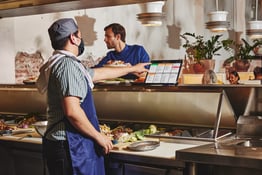An automated restaurant, or robotic restaurant, uses artificial intelligence to perform a range of tasks — chopping vegetables, washing dishes, delivering food, or taking orders. Machines replace varying amounts of the work typically done by restaurant and kitchen staff. And the robots are here to stay, so long as costs (wages, rent, food costs) keep rising. Used right, robots and automation in the food service industry can make workplaces safer, maintain high productivity and quality, and make a restaurant more profitable. As the tech improves and its costs drop, look for it to replace more and more workers in restaurants.
What are the benefits of robotics and automation in restaurants?
Streamlining the kitchen: Whether it’s rolling pizza dough or flipping burgers, robots can take a lot of the prep work away from kitchen staff, freeing them up to do other important culinary work. Robots are particularly good at repetition, completing their programmed tasks more efficiently and more uniformly than a person.
Lowering operational costs: Robots work long hours on the cheap. If you can handle the upfront costs, you’re likely to save on payroll. Plus, hiring these days is hard.
Customers dig them: Simplifying kitchen and operational processes make for a more seamless, more consistent dining experience for customers. Plus robots can add an entertainment element to dining. They’re kind of new and cool and fun. Show them off — people will come just to watch.
Who uses robotics and automation in restaurants?
Fast-food chains, cruise ship lines, and even small-scale restaurants have dabbled in robots and automation. Most notably, Domino’s Pizza launched “Domino's Anywhere,” allowing customers to order through robot-synced devices including Google Home and Amazon’s Alexa. They’ve also been one of the first to experiment replacing drivers with robots for delivery, transforming the entire process into one with no human interaction or contact whatsoever. Cruise ships use robotic bars to sell more cocktails in a fraction of the time using a voice-activated and touchscreen service that wows passengers. Japanese restaurants have employed robots behind the bar to roll out sushi in front of curious spectators. Robots are flipping burgers as well as crafting salads to be sold out of a vending machine. If there’s an effective and affordable way for restaurants to integrate automation in order to drive sales and traffic, they’re doing it.
Why do restaurants use robotics and automation?
Unlike practically every other part of the economy since the industrial revolution, restaurants have remained oddly immune from the creep of automation. But as robots get better at doing delicate tasks, and people become more accustomed to the sight of a machine handling kitchen tasks, it’s truly a matter of time before they take on more and more work. Robots work cheap, don’t get tired, don’t make mistakes, and take instructions like champs. The human touch will always have a cherished place in food and hospitality, but the machines are going to be doing more of the grunt work for us into the future.
[Photo by Handy Wicaksono on Unsplash]





